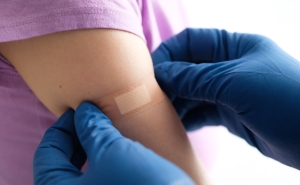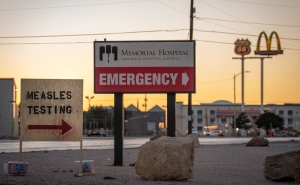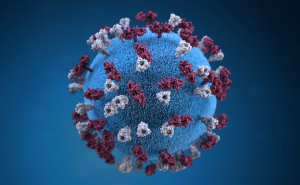What’s Ahead? Viral Mutations and Global Vaccinations

Interview by Stephanie Desmon
While we have much to learn about omicron, the new coronavirus variant, two things are certain: Vaccinations will provide some level of protection, and until the majority of the world’s population is vaccinated, we may continue to see new variants.
In this Q&A adapted from the Public Health On Call December 15 episode, vaccine experts Anna Durbin, MD, director of the Center for Immunization Research, and William Moss, MD, MPH, executive director of the International Vaccine Access Center, talk with Stephanie Desmon about what may lie ahead when it comes to viral mutations of SARS-CoV-2, how to address ongoing challenges of global vaccine distribution, and the importance of sharing vaccine technology to help curb future pandemics.
SD: We are just hearing about the omicron variant. What do we know about vaccines and this new variant, which has many mutations?
AD: We know that the variant has multiple mutations, but I do want to stress that it is still the spike protein of SARS-CoV-2. So although there are many mutations, there are so many parts of the protein that are the same that are contained in the vaccine. I'm predicting that antibodies don't neutralize or kill the virus as well as it might [kill] the original strain, but people will have what we call ‘memory’ because they’ve been vaccinated. A person’s immune response will recognize parts of the omicron virus, and that will provide some protection—we just don’t know how much. We’re still waiting for data to come in to see how severe omicron infections are in both vaccinated and unvaccinated people and just how transmissible it [the variant] is.
SD: Bill, what we’re hearing is that we should all run out and get boosters now that omicron is here. How do you feel about that?
WM: We don't know how long the protection from a booster will last, but I think it's a reasonable suggestion in the absence of real evidence, and we're going to have some of that evidence in the coming weeks.
The biggest threat right now in the U.S. is the delta variant. We're still seeing 80,000 cases a day, and 800 or so deaths a day. So booster doses may play a role in helping at least reduce those somewhat as well.
SD: As we move toward 2022, the number of people who are vaccinated in Africa is very low. Where does that leave us and what might we see going forward?
AD: I think that's everybody's concern. Until we get the world vaccinated, we're going to continue to see new variants arise. Globally, we need to do a much better job in getting these highly effective vaccines and these vaccine technologies to parts of the world so that they can produce the vaccine and deliver it to their own population. Just like here in the United States, there’s a lot of misinformation and disinformation and vaccine hesitancy in other parts of the world. We have to work on that globally to ensure that when vaccines are available, they will be used.
SD: Bill, how does a lack of vaccination contribute to more variants?
WM: It’s simple. The more opportunities this virus has to be transmitted, the more opportunities we’re giving it to develop a mutation. All viruses—and this virus in particular—are mutating all the time. Most mutations are actually not helpful to the virus and are dead-end mutations. But a mutation or a combination of mutations can result in making the virus more transmissible and make the virus evade our immune response.
Those are advantageous mutations to the virus, and those are the ones that are then going to persist as virus transmission goes forward. As long as there are susceptible individuals and we're providing the virus with opportunities to be transmitted, the virus will continue to mutate and potentially develop mutations that are harmful to us.
AD: The longer the virus can replicate or reproduce within a host, the more opportunity for mutations to occur.
SD: That's a scary scenario. It sounds like this is going to get all of us.
WM: Well, no. The caveat is that there isn't an infinite variety of mutations that are going to be advantageous to the virus—there are evolutionary constraints on viral evolution. Through the spike protein, the virus needs to bind to our receptors on our cells in order to get into our cells and replicate. So there may be mutations [involving the spike protein] that may evade our immune system but that hinder the virus’s ability to attach to our cellular receptors [and replicate], [so] those mutations are not going to [perpetuate]. I would think that, at some point, the virus is going to hit an optimal combination of mutations and settle on that.
SD: So this thing isn't ending anytime soon.
WM: It's not ending anytime soon, but there will be a slow down at some point. I think we will reach a truce.
SD: Returning to the topic of Africa, we’ve discussed how there is very little vaccination being done there, as well as in parts of Asia. Talk to me about why there’s a shortage of vaccination. Are there poor distribution methods? Are wealthy countries hoarding?
AD: It's a little bit of everything, but the largest driving factor is that the vaccines just aren't available. The highly effective mRNA vaccines, even some of the adenovirus-vectored vaccines, aren't being provided in large enough numbers to these countries.
To be frank, I think both Pfizer and Moderna are really focusing on selling these vaccines to higher-income countries instead of providing them at very low cost to low- and middle-income countries who really need them. There are some inactivated vaccines that are being provided, however, those have been shown to be much less effective and have a much shorter duration of effectiveness than the mRNA vaccines and the adenovector vaccines. Distribution is a problem, however, as they've improved the stability of these vaccines and the storage conditions, those concerns have been lessened.
There is also a lot of vaccine hesitancy, just as there's misinformation here in the U.S. … and it's not unique to COVID vaccines. There have been issues of misinformation and disinformation around polio vaccines in Africa. It’s multifactorial, but I think we really need regional production facilities for vaccines for situations like this pandemic. Until we get the world vaccinated, we're going to continue to see the emergence of new variants.
WM: I like to refer to the four d’s when thinking about what makes a successful vaccination campaign: doses, delivery, demand, and data.
- You need to have the doses available. This is especially a problem in sub-Saharan Africa, with the delays of COVAX getting vaccines to the low-income countries.
- Delivery. Countries need to have the supply chains and the personnel to be able to deliver these vaccines, and that can be a challenge in some resource-limited settings.
- Having the demand. Misinformation and disinformation need to be addressed.
- Lastly, good data is necessary to be able to track who's being vaccinated, particularly with a multi-dose vaccine. At a national level, a country needs to be able to track whether you're reaching the vulnerable populations or the target populations that you want to.
SD: Any thoughts on how we can make sure that happens?
AD: It’s going to require continued efforts, such as campaigning. There's a lot of resistance, particularly from these large vaccine manufacturers to share their technology, and that’s a mistake.
Moving forward, I think there will continue to be investigations into this pandemic [asking] what could we do better? As public health practitioners and public health officials, I think it is incumbent upon us to continue to raise this issue. How do we ensure there's equitable access and distribution of vaccines globally? It doesn't just benefit countries in Africa and Asia; it benefits everyone in the world because we need to stop the virus everywhere.
WM: There needs to be longer-term investment in building the capacity for vaccine manufacturing and distribution in all regions of the world so that they're not dependent on the high-income countries outside the region.
SD: We're seeing in some places that the rates of COVID cases and deaths are higher than ever, even though we have a vaccine that is very effective. Why is this happening?
WM: There are a number of factors that contribute to that, but there is still a large proportion of people here in the United States—and around the world—of people who are unvaccinated. I would say the number one thing is to raise vaccination coverage. Some countries are doing quite well on that, but most of the world is still lagging, and we're certainly still lagging here in the United States.
We can also prevent transmission of any SARS-CoV-2 variant, no matter how many mutations it has, by wearing masks and distancing. Lockdowns, closing schools and workplaces, and travel restrictions have huge economic and social costs, but I think even with just the basic public health measures that we can take, we can help control virus transmission.
AD: I could not agree with Bill more. I think where you're seeing it, particularly here in the U.S., is where you have pockets of unvaccinated people where it can spread. We know the delta variant, in particular, is highly transmissible and can grow to higher concentrations within unvaccinated hosts. We can only hope that omicron is not as effective in terms of its transmission and replication as delta, and I think only time will tell.
Stephanie Desmon is the co-host of the Public Health On Call podcast. She is the director of public relations and marketing for the Johns Hopkins Center for Communication Programs, the largest center at the Johns Hopkins Bloomberg School of Public Health.





